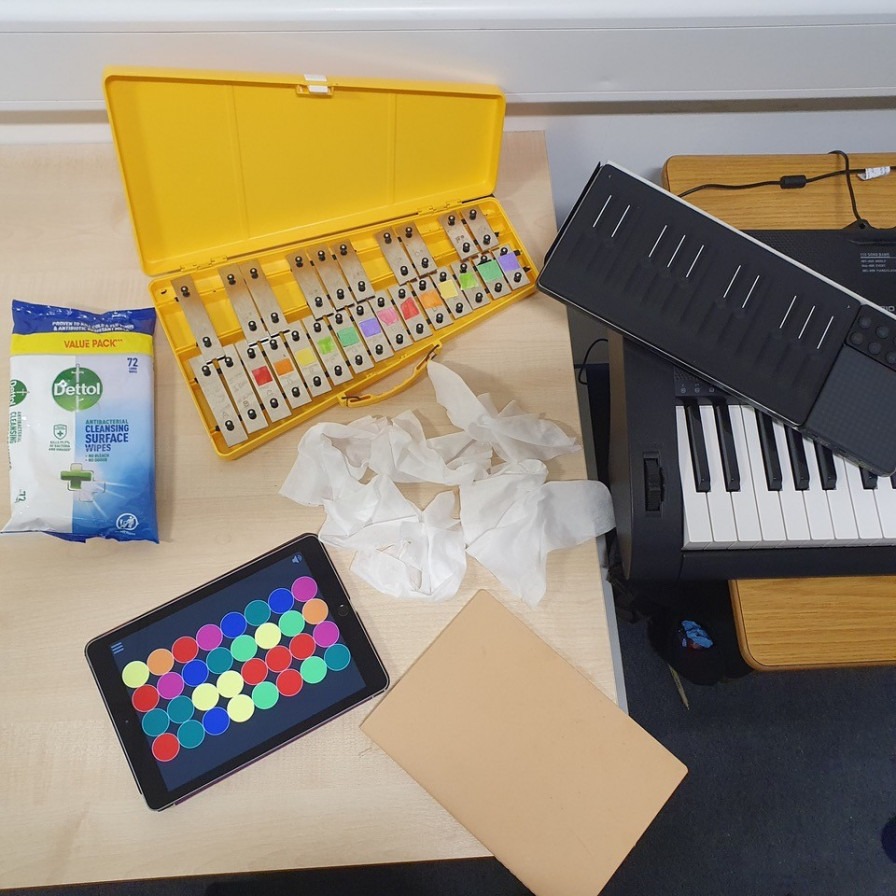Facilitation During a Pandemic by Luke Crook

To say it’s been an unusual year for music facilitation would be a gross understatement. My plans for a few inclusive music project pilots in 2020 quite quickly went onto the backburner in the spring as our hub went headlong into embracing a new, virtual world of music delivery and facilitation. We’ve probably all spent more time on Teams and Zoom than any of us ever thought possible, and I have been thoroughly impressed and heartened by the flexibility and innovation of both our teachers and staff at Kent Music as well as colleagues and musicians across the country and world!
As exciting and interesting virtual delivery has been, and I’m sure others would agree, I was missing face to face, in person delivery. Being able to play, in real time, in a room with participants has always been my favourite part of being a facilitator, and very little comes close. Understandably, this was paused whilst we waited for government guidance on how and when we could deliver in person again. So, when 2 special schools I work with said they wanted to continue, as planned, with their new Open Orchestra project in person I was equally elated and nervous. My planning for the project to this point had been focused around how to include as many accessible instruments as I could for a very diverse set of needs, but now I had to factor in how best to keep the participants, staff, myself and in turn their families and colleagues around them safe throughout all of this. As a result, I’ve now taken to referring to myself as ‘Anti-bac Man’ because of the sheer number of wipes, gels and sprays I carry in my backpack and the frequency at which I’m washing or anti-bac gelling my hands up from when I leave the house to when I get home!
Before I go any further, I really need to pay tribute to both schools for their flexibility, positivity and support in making sure their students got to take part in this project, and that I could come in to deliver it. Honest conversations, risk assessments, room jiggling, sanitisation stations, welcoming reception and office staff, and a real, deep willing for music (and wider arts) to continue on despite what was going on in the world outside of the school gates. They are a testament to their schools and peers.
So, what does a session look like? It goes a little something like this. Get to the school, sanitise and put my mask on, sign-in, catch up with my co-facilitator, head to the music room (sanitising along the way), get out iPads, Skoogs, keyboards, Seaboards and any other instruments we have and sanitise them, set up the room, get the student in, check they’ve sanitised and have a mask on if necessary, and then play, rinse and repeat. It would feel just like any other workshop pre-lockdown, if it wasn’t for the consistent sanitisation, wearing a mask and the distance I have to keep from others in the room.
Sadly, as I write this, both schools have had to cancel all external delivery due to Covid, both in the schools and the community. But this has now given us an opportunity to use all the new skills and techniques we learnt earlier in the year when we were forced to teach online. The rest of my week is now filled up with planning and recording video content for the participants, demos of different technology, apps and instruments they can experiment with, performances of the piece by other orchestras, Open or otherwise. I’m also doing a separate series of videos for both staff and parents or carers, explaining how to get different apps, adjust settings to improve access, explaining the colour system for notes and much more. All this, so that when we return to in person, we’ll be able to pick up where we left off, and maybe even with some new ideas, sounds or approaches from those involved.
I’ve been very lucky that both schools were game for face-to-face delivery to continue, particularly given that they are special schools with potentially vulnerable students. Within our hub we’ve had differing results with schools and tuition. Some are happy with face-to-face, provided that risk assessments and procedures are followed. Others have said no to all external activity, despite the guidance. Some have allowed us to deliver virtually in the schools as a compromise. It has not been all plain sailing. But what I will say is that in-person delivery is possible in the current situation. It took honest, positive and respectful conversations about what the school required to make it happen, what we at the hub required, flexibility, compromise and a shared goal that these young people would not miss out on an amazing musical opportunity.

